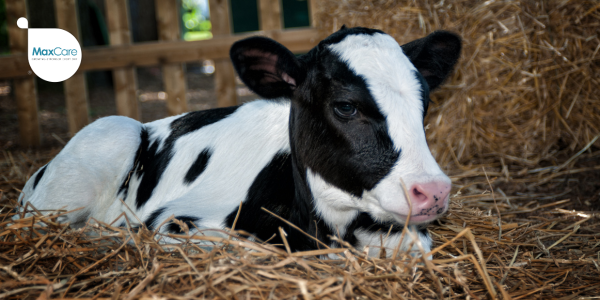Calves are exposed to multiple pathogens, but whether they get sick depends on how much pathogen a calf is exposed to and how their immune system responds.
During the first two weeks after birth, the health and future productivity of a calf is at high risk. This is because during this time, a calf’s body still needs to develop its immunity as well as its gastrointestinal (GI) tract. When a calf is born, its gut wall is permeable, so it can absorb antibodies from colostrum to develop its immunity. However, this can also make it easier for disease-causing organisms known as pathogens to pass through the gut wall and cause illnesses in calves.
Although a calf’s GI tract develops rapidly, attaining robust immunity takes time. Feeding high-quality colostrum, combined with reducing exposure to common farm pathogens, will help optimize a newborn calf’s health, growth and productivity.
Common farm pathogens:
The most frequent causes of death in pre-weaned calves are the result of GI diseases caused by pathogens. More specifically, rotavirus, coronavirus and cryptosporidium pathogens cause 95% of infectious scours cases in calves under 3 weeks old. The common pathogens and the age at which calves will commonly be infected are:
Bacteria:
- E. coli (1 day to 7 days old)
- Salmonella (5 days to 14 days old)
- Salmonella enterica subspecies enterica serovar Dublin (S. enterica Dublin) (14 days to 60 days or older)
- Clostridium (7 days and older)
Protozoans:
- Cryptosporidium (5 days to 30 days old)
- Coccidia (3 weeks old up to 1 year old)
Viruses:
- Rotavirus (14 days to 21 days old)
- Coronavirus (7 days to 10 days old)
Most calves are exposed to these pathogens. Whether they get sick depends on how much pathogen a calf is exposed to and how well their immune system responds. One of the keys to keeping calves healthy is reducing disease causing pathogens at their source using proper hygiene procedures.
The three primary pathogen exposure points for newborn and pre-weaned calves are calving pens or paddocks, calf housing, and calf feeding equipment/utensils. By systematically identifying the primary pathogens at each of these exposure points, a producer can select the most efficacious hygiene protocol to reduce harmful pathogens in the calf’s environment.
Although monitoring and documenting the effectiveness of a sanitation protocol is important, the identification and isolation of sick animals may also need to be implemented to prevent the further spread of disease.
Calving Areas :
For optimal newborn health, calves must be delivered in a clean, dry area, maintaining minimal pathogen exposure. In general, coliform bacteria (from faecal matter) are the most dangerous pathogens present in every calving area.
Navel Dipping: Careful and consistent navel dipping is a hygiene step that not only kills pathogens at the navel opening but also helps close the umbilical cord.
Separation of Calf from Dam: Separating the calf from the dam shortly after birth is an important hygiene procedure. By controlling this aspect of the calf’s environment, you are removing a huge source of faecal bacteria from the calf’s environment.
Colostrum management: To put it simply, the number one goal of colostrum is to deliver an adequate amount of immunoglobulin G (IgG) to calves as quickly and cleanly as possible. Colostrum is vital to the newborn calf to provide immunity and it is also rich in essential nutrients to provide energy for growth. Failure to absorb enough IgG (antibodies) from colostrum in the first 24 hours of a calf’s life makes the calf more susceptible to disease and death. This is known as Failure of Passive Transfer (FPT) and is relatively common.
Good management practices (the four Qs – Quality, Quickly, Quantity and sQueaky clean) can limit the chance of FPT.
- Quality – Colostrum should be harvested as soon as possible after a cow has calved. It is important to test colostrum quality, which can be done using a Brix refractometer to assess the antibody concentration in the colostrum before it is fed, stored or discarded. It is recommended that percent Brix colostrum readings be greater than or equal to 22 percent, to ensure high quality colostrum and increase the probability of adequate passive immunity in calves.
- Quickly – Feed calves as soon as possible, remembering the calf can only absorb antibodies for a short time after birth.
- Quantity – The recommendation is to give a first feed of 3 litres or 10% of body weight. This should be followed up by another similar size feed within 12 hours of birth. The colostrum should be fed at body temperature which is 38°C.
- sQueaky clean – Make sure the colostrum is collected hygienically into clean collection containers. If storing colostrum, refrigerate or freeze quickly and avoid pooling from different cows.
Pre-Weaned Calf Housing:
Many components of a calf’s immune system are not functional until 2 to 4 weeks old. Protect younger calves by putting them first. Do this by feeding and handling the youngest animals first during all interactions and by cleaning their equipment first or with separate clean water.
For all pre-weaned calves, the best protocol is to change latex gloves or rinse gloved hands in a detergent solution between each calf interaction. Also, don’t wait to clean dirty feeding equipment such as bottles, nipples and oesophageal feeders. When left at room temperature, the bacteria count on these items will double every 20 minutes.
Regarding cleanliness, looking clean doesn’t mean clean. Removing the visible manure, dirt and milk from feeding equipment is just the starting point. Follow this step by sanitizing equipment with a detergent and an acid to kill pathogens that are embedded in biofilms. Biofilms are primarily composed of fats, proteins and carbohydrates. Washing with a chlorinated alkaline (pH of 11 to 12) detergent and rinsing with an acidic (pH of 2 to 3) solution will remove them.
Keep calves away from wet conditions that support pathogen survival and growth. Providing ample drainage and a dry environment is an effective weapon against bacteria and parasites.
Cleaning Calf Hutches/Pens with Sand/Clay Flooring:
- Remove the bedding and top layer of sand/clay between calves.
- Spray top layer of sand/clay with 100 PPM of chlorine dioxide.
- Let dry for approximately 1 hour prior to re-bedding calf hutch.
- Apply a chlorinated alkaline foaming detergent with hot water (60°C) to all pen surfaces using a handheld foamer. Soak for approximately 10–15 minutes.
- Rinse with water. Allow pens to dry.
- A solution of 100 PPM of chlorine dioxide, should be sprayed on all pen surfaces for maximum hygiene protection. Allow to dry prior to re-bedding the pen.
Calf Feeding Equipment/Utensils Hygiene Procedures:
As feeding equipment comes in direct contact with the calf’s mouth, disinfection is crucial in preventing the spread of disease. Careful attention to cleaning protocols will decrease the pathogenic load on bottles, nipples, buckets and other feeding equipment resulting in healthier calves.
Cleaning Calf Feeding Equipment and Utensils:
- Rinse all equipment/utensils with warm water (45°C) removing organic material before washing.
- Soak the equipment/utensils in hot water (60°C) with a chlorinated alkaline detergent (pH of 10–11) for approximately 5 minutes.
- Wash vigorously with a brush for 1–2 minutes.
- Remove alkaline solution and fill sink with cold rinse water.
- Add chlorine dioxide to the rinse water creating a 50 PPM chlorine dioxide solution.
- Let sit and allow to air dry prior to use.
When drying and storing equipment, choose a clean, dry area away from the damp sink and washing room. Do not stack the pails together until completely dry, and do not place any equipment in contact with the ground after sanitizing.
One final recommendation is to sanitize the surface of feeding equipment with chlorine dioxide right before use to kill any accumulated pathogens. This step can be done quickly with a pump sprayer.
Identify what is causing the illness:
Finding the source of infection is essential to prevent the spread and creation of new cases. Faecal-oral transmission is the traditional way for many pathogens to infect calves, but it is not the only route. Salmonella, for example, is a highly resistant pathogen and can exist in livestock and the environment for up to two years. Therefore, every infected part of the environment (calves, faeces, flies, rodents, water, feed, birds, etc.) can become a vector for transmitting the pathogen (Table 1).
| TABLE 1 | Every infected part of the environment (calves, faeces, flies, rodents, water, feed, birds, etc.) can become a vector for transmitting the pathogen | ||
| Pathogen | Duration of shedding | Persistence in the environment (Up to) | |
| E. coli | 2 days | 3 months | |
| Rota/Corona viruses | 6 days | 1 year | |
| Salmonella | 30 to 50 days | 2 years | |
| Cryptosporidium | 10 days | 2 years | |
In summary, implementing these sanitation protocols will reduce the load of pathogens calves are exposed to every day. An effective sanitation protocol gives the immune system the advantage it needs to keep calves healthy, saving you time and money by reducing treatments.
Ready to elevate your calf hygiene practices? Reach out to the MaxCare team today.




